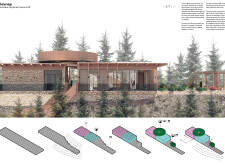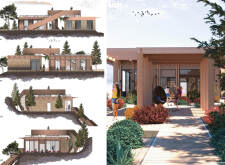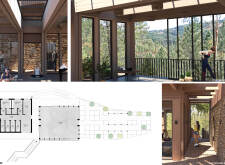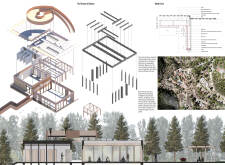5 key facts about this project
At its core, *Chaturanga* represents not just a physical structure but a concept aimed at enhancing well-being. The architecture prioritizes flexibility, allowing practitioners to engage with the space in diverse ways. The design encourages movement, facilitating both solitary practices and community gatherings, thus fulfilling its role as a multifunctional retreat.
One of the most important aspects of this project is its seamless integration with the natural environment. Positioned on a cliff, the retreat offers breathtaking views of the lush landscape, promoting a sense of tranquility and inspiration. The architectural form has been carefully crafted to blend with the contours and features of the terrain, ensuring minimal disruption to the existing ecology.
Materials play a crucial role in defining the character of *Chaturanga*. Local stone is prominently used for exterior walls, providing a natural aesthetic that connects the building to its site while ensuring durability. Timber is employed throughout the interior spaces, creating a warm and inviting atmosphere. The choice of sustainably sourced timber aligns with the retreat's commitment to environmental responsibility. Expansive glass elements facilitate an abundance of natural light, blurring the boundaries between inside and outside and enhancing the overall experience of openness.
The architectural design introduces unique features that set *Chaturanga* apart. A circular observation deck at the top of the building allows visitors to engage with their surroundings while providing a serene space for reflection and contemplation. This deck features a spiral pathway that enhances the experience of ascending into the sky, inviting individuals to appreciate the natural beauty from various perspectives.
A well-designed zen garden serves as another focal point within the retreat, featuring native plants and carefully landscaped areas that promote mindfulness. This outdoor space is not merely an aesthetic addition but a functional area that encourages users to connect with nature and engage in relaxation practices.
The layout of *Chaturanga* emphasizes an open plan concept, minimizing physical barriers between different spaces. This thoughtful design approach fosters interaction and promotes a sense of community among retreat participants, allowing for effortless transitions between yoga classes, meditation sessions, and informal gatherings. By embracing an open design, the project successfully creates an environment where individuals can feel both connected and at ease.
The geographical context of Vale de Moses is intrinsic to the architectural response of the retreat. The local landscape inspires the design, ensuring that the retreat is harmoniously aligned with its setting while also responding to the area's unique climate and topography. This careful consideration of location enhances the overall user experience, reinforcing the project's commitment to wellness and nature.
For those interested in delving deeper into the architectural nuances of the project, it is worth exploring the detailed architectural plans, sections, and designs. These elements provide valuable insights into how *Chaturanga* achieves its intended purpose through careful consideration of materials, space, and environment. Engaging with these resources can foster a greater appreciation for how architecture can facilitate wellness and inspire tranquility within a beautiful natural context.


























